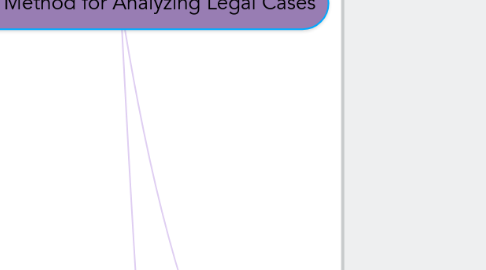
1. First step: solve the IRAC Triad
1.1. Step 1: What circumstances gave rise to the law suit? ( In other words - what is the story?)
1.1.1. Are there buzzwords in the facts that suggest an issue?
1.1.2. Read the case carefully to identify the relevant facts
1.1.3. What are the non-issues?
1.2. Step 2: After becoming familiar with the facts, identify the issue. What question is the court being called on to resolve?
1.2.1. Identify the rule of law. What legal principles will the court use to resolve the dispute
1.2.1.1. The legal issue would not exist unless some event occurred.
1.2.1.2. The issue mechanically determines what rule is applied.
1.2.2. In determining the issue before the court - consider whether the court is deciding a question of fact - i.e. the parties are in dispute over what happened - or a question of law - i.e. the court is unsure which rule to apply to these facts?
1.3. Step 3: What legal principle for rule of law will the court rely on to address the issue you identified?
1.3.1. What are the elements that prove the rule?
1.3.2. From what authority does it come? Common law, statute, new rule?
1.3.3. What's the underlying public policy behind the rule?
1.3.4. Are there social considerations?
1.3.5. What are the exceptions to the rule?
1.4. Step 4 Apply the facts to the rule of law to form the Analysis.
1.4.1. Which facts help prove which elements of the rule?
1.4.2. Why are certain facts relevant?
1.4.3. How do these facts satisfy this rule?
1.4.4. What types of facts are applied to the rule?
1.4.5. How do these facts further the public policy underlying
1.4.6. What's the counter-argument for another solution?
1.4.7. Do the facts satisfy the requirements of the rule?
2. Second step: Now, rewrite in IRAC format:
2.1. What facts and circumstances brought these parties to court? This should actually be "1." and called Facts
2.2. 1. Issue
2.2.1. What is the question before the court? (Hint in legal opinions it is usually introduced with the word "Whether. . . "
2.3. 2. Rule
2.3.1. What is the governing law for the issue?
2.4. 3. Analysis
2.4.1. Apply the facts to each element of the law
2.4.2. Does the rule apply to these unique facts?
2.5. 4. Conclusion
2.5.1. "From the analysis you come to a Conclusion as to whether the rule applies to the facts." Where are these quotes coming from?
2.5.2. How does the court's holding modify the rule of law?
